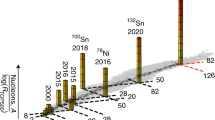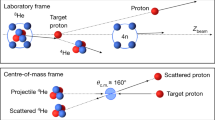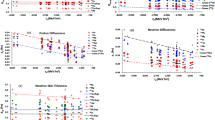Abstract
I RECENTLY pointed out in these columns1 that experimental evidence indicates that the heights of the potential barriers of the light nuclei are proportional to the atomic number. This simple relation can be shown to fit in with Heisenberg's suggestion2 that nuclei are composed of protons and neutrons and that there is an attractive force J(r) between neutron and proton at close distances, and between neutron and neutron K(r), the former being the greater. An α-particle contains two neutrons and two protons, a nucleus contains n1 neutrons and n2 protons; there will therefore be an attractive force between nuclear neutrons and -particle protons and nuclear protons and -particle neutrons, superposed on the Coulomb repulsion between protons. Thus we have (neglecting the neutron-neutron force K(r), since it is less than J(r)): for the potential at a distance r. I have assumed a law of force of the form to represent J(r). This gives . It happens that for the light elements n1 is very nearly equal to n2, never differing by more than one unit. Thus we have approximately, This gives for Vc the maximum when dv/dr = 0 the value If p is constant, that is, if the law of force is the same from element to element, we have that Vc is a straight line function of n2, which is what is found experimentally.
This is a preview of subscription content, access via your institution
Access options
Subscribe to this journal
Receive 51 print issues and online access
$199.00 per year
only $3.90 per issue
Buy this article
- Purchase on SpringerLink
- Instant access to full article PDF
Prices may be subject to local taxes which are calculated during checkout
Similar content being viewed by others
References
E. C. Pollard, NATURE, 131, 97, Jan. 21, 1933.
W. Heisenberg, Z. phys., 77, 1; 1932.
Author information
Authors and Affiliations
Rights and permissions
About this article
Cite this article
POLLARD, E. Heights of Nuclear Potential Barriers and Nuclear Structure. Nature 131, 398 (1933). https://doi.org/10.1038/131398a0
Issue date:
DOI: https://doi.org/10.1038/131398a0



